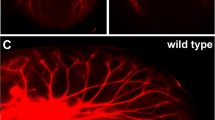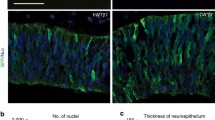Summary
Lingual epithelial cells, including those of the taste buds, are regularly replaced by proliferative stem cells. We found that integrin β1, a keratinocyte stem cell marker, was expressed at the basal layer and taste buds of adult mouse tongue epithelium. We purified and cultured integrin β1-positive cells (termed KT-1 cells), whose growth was stimulated by epidermal growth factor (EGF) and basic fibroblast growth factor (FGF-2). FGF-2 stimulation induced translocation of the FGF type I receptor (FGFR1) into nuclei, suggesting that the growth-stimulating effect of FGF-2 was mediated through FGFR1. EGF and FGF-2 also regulated cell surface expression of the neural cell adhesion molecule (N-CAM) in KT-1 cells. Anti-N-CAM antibody immunoreactivity was restricted to the gustatory epithelium and the nerves in the tongue epithelium, giving rise to the possibility that KT-1 may contain gustatory epithelial cells. KT-1 cells may thus be useful for analyzing the factors that regulate the growth and differentiation of lingual and gustatory epithelial cells in vitro.
Similar content being viewed by others
References
Akiyama, M.; Smith, L. T.; Shimizu, H. Changing patterns of localization of putative stem cells in developing human hair follicles. J. Invest. Dermatol. 114:321–327; 2000.
Albert, M. R.; Foster, R. A.; Vogel, J. C. Murine epidermal label-retaining cells isolated by flow cytometry do not express the stem cell markers CD34, Sca-1, or Flk-1. J. Invest. Dermatol. 117:943–948; 2001.
Boyce, S. T.; Ham, R. G. Calcium-regulated differentiation of normal human epidermal keratinocytes in chemically defined clonal culture and serum-free serial culture. J. Invest. Dermatol. 81:33s-40s; 1983.
Chainani-Wu, N.; Lagenaur, L. A.; Penaranda, M. E., et al. Integrin expression in oral hairy leukoplakia and normal tongue epithelium. Oral Dis. 6:234–240; 2000.
Forootan, S. S.; Ke, Y.; Jones, A. S., et al. Basic fibroblast growth factor and angiogenesis in squamous carcinoma of the tongue. Oral Oncol. 36:437–443; 2000.
Gritti, A.; Frolichsthal-Schoeller, P.; Galli, R., et al. Epidermal and fibroblast growth factors behave as mitogenic regulators for a single multipotent stem cell-like population from the subventricular region of the adult mouse forebrain. J. Neurosci. 19:3287–3297; 1999.
Hirota, M.; Ito, T.; Okudela, K., et al. Expression of cyclin-dependent kinase inhibitors in taste buds of mouse and hamster. Tissue Cell 33:25–32; 2001.
Houchen, C. W.; George, R. J.; Sturmoski, M. A., et al. FGF-2 enhances intestinal stem cell survival and its expression is induced after radiation injury. Am. J. Physiol. 276:G249-G258; 1999.
Jones, P. H.; Watt, F. M. Separation of human epidermal stem cells from transit amplifying cells on the basis of differences in integrin function and expression. Cell 73:713–724; 1993.
Kang, M. K.; Bibb, C.; Baluda, M. A., et al. In vitro replication and differentiation of normal human oral keratinocytes. Exp. Cell Res. 258:288–297; 2000.
Lillien, L.; Cepko, C. Control of proliferation in the retina: temporal changes in responsiveness to FGF and TGF alpha. Development 115:253–266; 1992.
Maher, P. A. Nuclear translocation of fibroblast growth factor (FGF) receptors in response to FGF-2. J. Cell Biol. 134:529–536; 1996.
Maruoka, Y.; Harada, H.; Mitsuyasu, T., et al. Keratinocytes become terminally differentiated in a process involving programmed cell death. Biochem. Biophys. Res. Commun. 238:886–890; 1997.
Miura, H.; Kusakabe, Y.; Sugiyama, C., et al. Shh and Ptc are associated with taste bud maintenance in the adult mouse. Mech. Dev. 106:143–145; 2001.
Nagafuchi, A. Molecular architecture of adherens junctions. Curr. Opin Cell Biol. 13:600–603; 2001.
Nelson, G. M.; Finger, T. E. Immunolocalization of different forms of neural cell adhesion molecule (NCAM) in rat taste buds. J. Comp. Neurol. 336:507–516; 1993.
Oh, S. H.; Hayashi, Y.; Iseki, K., et al. Participation of ionotropic and metabotropic glutamate receptors in taste cell responses to MSG. Sensory Neuron 3:169–183; 2001.
Okamoto, T.; Yatsuzuka, N.; Tanaka, Y., et al. Growth and differentiation of periodontal ligament-derived cells in serum-free defined culture. In Vitro Cell. Dev. Biol. 33:302–309; 1997.
Palmer, T. D.; Ray, J.; Gage, F. H. FGF-2-responsive neuronal progenitors reside in proliferative and quiescent regions of the adult rodent brain. Mol. Cell Neurosci. 6:474–486; 1995.
Powers, C. J.; Mcleskey, S. W.; Wellstein, A. Fibroblast growth factors, their receptors and signaling. Endocr. Relat. Cancer 7:165–197; 2000.
Qian, X.; Davis, A. A.; Goderie, S. K., et al. FGF-2 concentration regulates the generation of neurons and glia from multipotent cortical stem cells. Neuron 18:81–93; 1997.
Reilly, J. F.; Maher, P. A. Import in beta-mediated nuclear import of fibroblast growth factor receptor: role in cell proliferation. J. Cell Biol. 152:1307–1312; 2001.
Smith, D. V.; Klevitsky, R.; Akeson, R. A., et al. Expression of the neural cell adhesion molecule (NCAM) and polysialic acid during taste bud degeneration and regeneration. J. Comp. Neurol. 347:187–196; 1994.
Stone, L.; Finger, T.; Tam, P., et al. Taste receptor cells arise from local epithelium, not neurogenic ectoderm. Proc. Natl. Acad. Sci. USA. 92:1916–1920; 1995.
Sun, H.; Oakley, B. Development of anterior gustatory epithelia in the palate and tongue requires epidermal growth factor receptor. Dev. Biol. 242:31–43; 2002.
Takeda, M.; Suzuki, Y.; Obara, N., et al. Expression of the neural cell adhesion molecule in mouse taste buds after denervation. J. Electron Microsc. 48:39–45; 1999.
Thomson, P. J.; Mcgurk, M.; Potten, C. S., et al. Tritiated thymidine and bromodeoxyuridine double-labelling studies on growth factors and oral epithelial proliferation in the mouse. Arch. Oral Biol. 44:721–734; 1999.
Tsutsumi, S.; Shimazu, A.; Miyazaki, K., et al. Retention of multilineage differentiation potential of mesenchymal cells during proliferation in response to FGF. Biochem. Biophys. Res. Commun. 288:413–419; 2001.
Whitcomb, S. S.; Eversole, L. R.; Lindemann, R. A. Immunohistochemical mapping of epidermal growth-factor receptors in normal human oral soft tissue. Arch. Oral. Biol. 38:823–826; 1993.
Whitehead, M. C.; Granchrow, J. R.; Granchrow, D., et al. Neural cell adhesion molecule, neuron-specific enolase and calcitonin gene-related peptide immunoreactivity in hamster taste buds after chorda tympani/lingual nerve denervation. Neuroscience 83:843–856; 1998.
Zhang, C.; Cotter, M.; Lawton, A., et al. Keratin 18 is associated with a subset of older taste cells in the rat. Differentiation 59:155–162; 1995.
Author information
Authors and Affiliations
Corresponding author
Rights and permissions
About this article
Cite this article
Ookura, T., Kawamoto, K., Tsuzaki, H. et al. Fibroblast and epidermal growth factors modulate proliferation and neural cell adhesion molecule expression in epithelial cells derived from the adult mouse tongue. In Vitro Cell.Dev.Biol.-Animal 38, 365–372 (2002). https://doi.org/10.1290/1071-2690(2002)038<0365:FAEGFM>2.0.CO;2
Received:
Accepted:
Issue Date:
DOI: https://doi.org/10.1290/1071-2690(2002)038<0365:FAEGFM>2.0.CO;2




